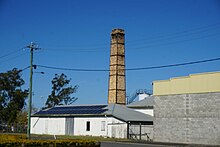South Burnett Co-operative Dairy Association Factory
This period also saw the introduction of sown pastures such as paspalum and Rhodes grass and the cultivation of fodder, to improve milk yields and to provide adequate feed during the less productive months of winter.
[1] The arrival of the Kilkivan branch railway to Murgon in 1904 was the impetus for the establishment of the township and a catalyst for the rapid expansion of dairying in the surrounding district, then an emerging but relatively small scale industry in the South Burnett.
In 1908 Tiaro Dairy Co-operative Company was established, with a butter factory built of timber opening in the township in the same year.
By 1912, 84 percent of the Tiaro butter factory's cream supply was sourced from the South Burnett and a correspondingly large number of the co-operative's shareholders were from the region.
Following the establishment of the Murgon butter factory, operations progressively expanded, reflecting the suitability and productivity of the South Burnett district for dairying.
The dual factory system, driven by a common power plant, was claimed at the time to be "unique in the history of butter production in the Commonwealth".
The new buildings were officially opened on 9 March 1929 by William Forgan Smith, Minister for Agriculture and Stock, with over 1000 invited guests and the township "en-fete" for the occasion.
By the end of the 1920s most Queensland butter factories had been remodelled or were new buildings of brick and concrete, replacing earlier timber structures.
In addition to upgrading buildings and equipment, greater attention was paid to ensuring butter was of a high standard, through stricter grading and modern processes of pasteurisation and neutralisation.
The transition towards the production of milk rather than cream, requiring larger herds and new equipment, saw many smaller scale farmers leaving the industry.
Export opportunities also became restricted, culminating with the end of preferential trade agreements with Britain following its entry into the European Common Market in 1973.
The SBCDA (later changed to Burnett Valley Ltd) were able to procure milk from QUF, which allowed for Murgon cheese to be continued to be manufactured, albeit in a much reduced capacity.
By 1995 butter production had ceased, and a decline in demand for the cheddar cheese forced the closure of the Murgon factory, marking the end of dairy processing at the site.
[1] The former Murgon Dairy Factory was purchased in 1998 by Clovely Estate and since this time has been utilised for wine making, an industry that has developed in the South Burnett since the early 1990s.
The site is a complex of buildings and structures tightly assembled with the main entrance from Macalister Street arriving to a rectangular bitumen-paved yard from which the loading dock of the factory worked.
[1] Fronting the loading yard to Macalister Street, the main building is a rectangular concrete shed distinguished by decorative stepped parapets which screen a gable roof clad with corrugated metal sheeting.
[1] The roof is framed with steel trusses and the ceiling is lined with a particle board sheeting joined with cover strips.
[1] Modern cold rooms and laboratory facilities occupy the northern part of the former external dock to Macalister Street.
[1] A rectangular steel framed and concrete shed sheltered by a gable roof clad with corrugated metal sheeting, the plant room stands to the middle of the site.
Two large 20-light steel framed windows punctuate the north-west wall and a double timber door opens to the south-east.
[1] An array of plant including engines, pulleys and belts, pipes, gauges, valves, exhaust fans and equipment associated with the ammonia chilling process is accommodated in the shed.
[1] Two cylindrical metal boilers with brick fireboxes framed with steel strapping are housed in a rectangular timber-framed shed sheltered by a hipped roof and clad with corrugated iron.
[1] Three later besser block buildings associated with the dairy processing business - one to the north corner of the site and two south-east of the former Tiaro structures - are not considered to be of heritage significance.
[1] The site accommodates a number of recent structures that relate to the present wine making business including tanks and storage and cold rooms which are not of heritage significance.
[1] South Burnett Co-operative Dairy Association Factory (former) was listed on the Queensland Heritage Register on 9 November 2012 having satisfied the following criteria.
Adaptations and additions to the factory from the 1940s onwards reflect the shift from concentrating on butter manufacturing to processing cheese and milk products, in response to the changing market requirements of Queensland's dairy industry.
The 1929 engine room and its remaining fittings (ammonia compressor and piping), and other extant elements of the factory's plant (large brick chimney, boilers, sheds) demonstrate the industrial requirements of the complex over time.






